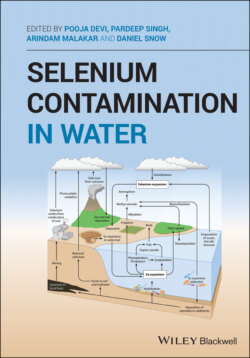Читать книгу Selenium Contamination in Water - Группа авторов - Страница 60
4.3.3 Pigs
ОглавлениеMiller and Williams (1940) reported that oral selenite intoxication with swine body weight of 13–23 mg Se/kg caused paresis, tremor, vomiting, anorexia, diarrhea, and depression (Figure 4.1). 10 ppm of sowing exposure results in toxicity, shown by reduced design rate, litter size, and piglet weight (Wahlstrom and Olson 1959). A study by Diehl et al. (1975) reported that 2.0 and 1.2 mg/kg body weight administration caused muscle tetany, increased plasma glutamic oxaloacetic transaminase (GOT) activity, and clinical signs of tremor, ataxia, etc. As observed in sheep and calves, acute and chronic Se toxicity has also emerged in young pigs. Acute Se toxicity in young lambs following selenosis manifested similar symptoms (Shortridge et al. 1971). Chronic Se toxicity induced sluggishness, lack of energy, emaciation, hair roughness, hair loss, sluggishness of hooves, damage to the liver, heart failure, etc. (Underwood 1979).
Figure 4.1 (a and b) Symptoms of selenosis in pigs (unthriftiness (a) and separation of the hoofs from the skin (b)).
(Source: Adapted from Wahlstrom et al. (1956)).
Toxicity varies according to the pigs’ genetic difference. Some of the studies have reported that pigs’ susceptibility to Se toxicity varied depending on pigs’ hair color (Wahlstrom and Olson 1959; Wahlstrom et al. 1984). Red‐haired pigs were more prone to Se toxicity than black‐ or white‐haired pigs (Wahlstrom et al. 1984). 4–8 mg Se/kg DM exerts Se toxicity in pigs in food grains; that also depends on the composition of food and other factors such as duration of exposure (Palmer et al. 1983; Goehring et al. 1984a; Goehring et al. 1984b). One study of a maize‐soybean diet with 8 mg Se/kg DM impaired appetite and growth within five weeks of exposure. However, for the same time duration this concentration in wheat and oats had no effect on the pigs (Goehring et al. 1984a; Goehring et al. 1984b). 12 mg Se/kg DM of feed caused hoof lesions in pigs, as in dairy cattle and horses (Goehring et al. 1984b). The concentration in pigs with 5, 10, and 25 mg Se/kg DM for 120 days resulted in hoof lesion, edema, hyperemia, extreme spinal cord lesions, paralysis of the body, emaciation, postnecrotic atrophic liver cirrhosis, and lumbal poliomyelomalacia, etc. and inflammation (Goehring et al. 1984b; O'Toole and Raisbeck 1995). Feeding meal diets of corn‐soybean along with 5 ppm of Se in swine results reduced growth and feed intake. The most influential measure of toxicity to Se is decreased growth rate. Up to 8.3 ppm Se addition in swine feed did not cause any health effects but after 12 ppm Se meal exposure caused hoof lesions (Mahan and Moxon 1980; Wahlstrom et al. 1984; Goehring et al. 1984b). The same diagnosis of hoof lesions was also published for Harrison et al. (1983) after exposure to Se. Poulsen et al. (1989) reported that after suckling the growth rate was stunted by exposure to Se, because the milk produced lower rates of Se than the feed received. They also reported that 16 mg of inorganic Se/kg feed along with diets based on barley produced no health hazards such as sow conception, number of piglets born, mortality rate, etc. But after Se supplementation, there was a tendency to lower piglet body weight as the colostrum and milk contained Se.
A higher dose of Se in feed also decreased feed intake, circular dark band on hoofs, and rate of gain following piglet weaning (Wahlstrom and Olson 1959; Goehring et al. 1984b; Mahan and Moxon 1984; Poulsen et al. 1989). Kim and Mahan (2001a) reported Se supplementation in swine muscle ad internal organs such as heart, kidney, liver etc. caused the higher Se accumulation. They also reported that inorganic Se caused serious swine problems. They came to this conclusion after feeding 0.3–10 ppm Se to the swine with organic and inorganic form Se. Results showed that exposure of 7–10 ppm Se for prolonged periods caused selenosis due to organic Se exposure after alteration of reproductive performance. On the other hand, inorganic Se during lactation period caused detrimental effects in the progeny (Kim and Mahan 2001b).
